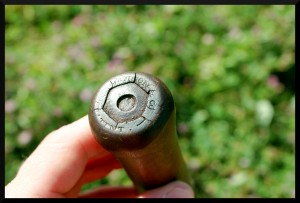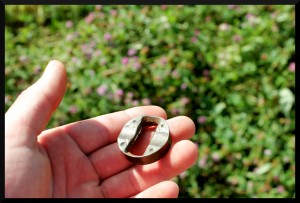Up until the mid 19th century, American scythes had used the English method of affixing their nibs: an iron loop was fastened to the shaft of the snath by means of a wedge driven between the loop and the snath itself. While this allowed the nibs to be positioned at will along the snath, the wedges were prone to working their way loose at inconvenient moments, and in the industrial boom of the mid-1800’s a number of innovations were made in the means of fastening nibs. The most notable of these is the method that eventually became the standard: the so-called “Clapp’s Patent” nib. Patented in 1838 by Joseph and Erasmus S. Clapp of Montague, Massachusetts, it was the first nib known to bear the form that we see so commonly today on almost all snaths, both new and vintage. The nibs made currently by Seymour Midwest Tools are effectively of the same fundamental design.
We were fortunate enough to come into possession of an original example of one of Clapp’s Patent nibs, as well as a contemporary clone by Lamson Co. This company was particularly notable, for its owner and founder, Silas Lamson, is commonly credited with having inventing the steam bent curved snath as we know it today. This innovation is often cited as having been in 1834, though we have documentation that places it as much as 6 years earlier. An 1830 document declaring his letters patent include, among other innovations, “the mode of fastening the nibs without wedges” although we do not know the specific mechanism used. As can be seen in the following photos, our Lamson nib is nearly identical to the Clapp one. The Clapp patent seems to have been at the center of a court case regarding patent infringement in 1840.
See first the Clapp’s Patent example:
The Lamson Co. nib:








































